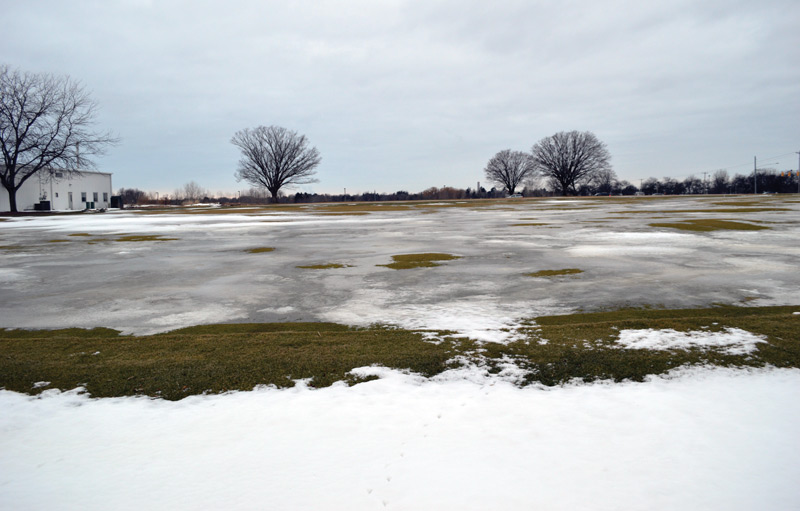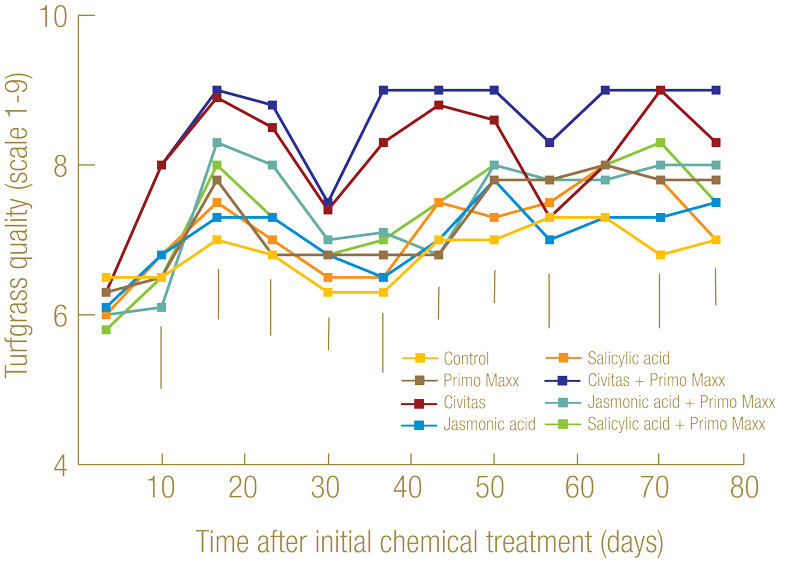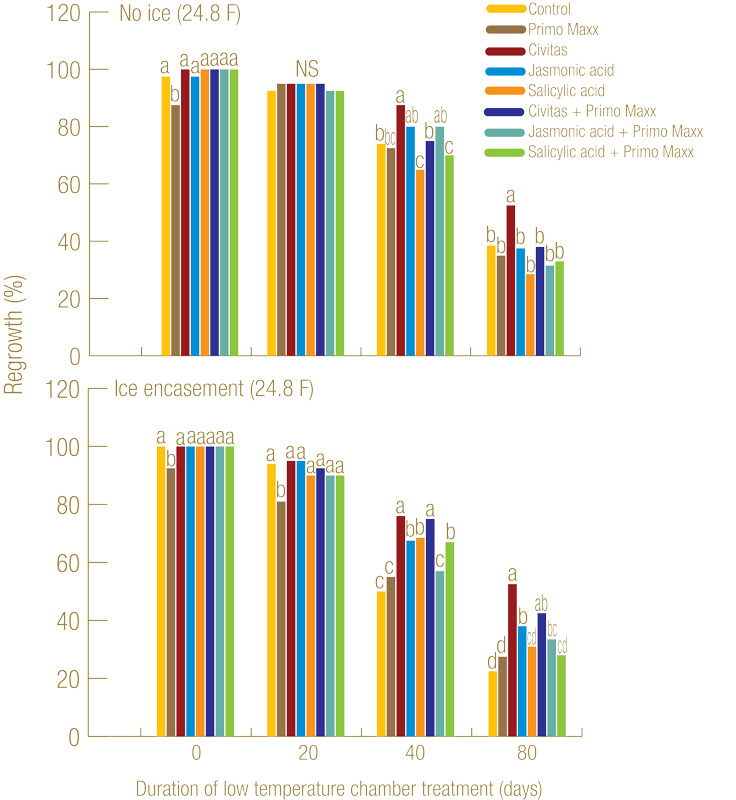
Ice encasement of putting green-height turfgrasses at the Hancock Turfgrass Research Center in East Lansing, Mich. Photo by Kevin Laskowski
Ice encasement is a common problem for putting green species, particularly annual bluegrass (Poa annua), in temperate areas. If ice encasement is prolonged, it can cause oxygen deficiency in the turf canopy and root zone as well as toxic gas buildup under the ice, and it can result in widespread death of turfgrass areas. Few winter preparatory management strategies exist for turfgrass managers, other than mechanical prevention of ice encasement by covering putting greens or laborious removal of ice.
Priming of plants with chemical treatments could be an efficient, less labor-intensive way to prepare turfgrasses for overwintering. Priming is an attempt to use a chemical or other external treatment to make plants more prepared to take on a subsequent stress. The turfgrass industry has commercially available products with priming agents as ingredients, but formal evaluation of these agents is lacking for abiotic stresses.
Here, we aimed to investigate the use of the plant hormones salicylic acid and jasmonic acid to improve annual bluegrass survival of ice encasement in comparison with a pesticide containing mineral oil (Civitas Turf Defense Pre-M1xed, Petro-Canada), which was previously found to enhance annual bluegrass survival of ice cover. Civitas-treated plants had a higher level of the fatty acid linolenic acid, a precursor to jasmonic acid, than control plants did (1). In the same study, a plant growth regulator that represses gibberellic acid biosynthesis, trinexapac-ethyl (Primo Maxx, Syngenta), decreased ice tolerance of annual bluegrass, but not on all days measured.
Given that gibberellic acid inhibition is such a common practice in the turf industry for mowing reduction and other purposes, a goal of this study was to evaluate turf priming in combination with gibberellic acid inhibition to study the effects on ice encasement survival.
Methods
Field and growth chamber studies in 2017 and 2018 were performed in a completely randomized design with four replications to evaluate the following treatments:
- Control, water only
- Primo Maxx (0.125 fluid ounce/1,000 square feet; 0.39 liter/hectare)
- Civitas (8 fluid ounces/1,000 square feet; 25.46 liters/hectare)
- Jasmonic acid (2 mM; 2 millimoles)
- Salicylic acid (20 µM; 20 micromoles)
- Civitas + Primo Maxx (8 fluid ounces/1,000 square feet + 0.125 fluid ounce/1,000 square feet)
- Jasmonic acid + Primo Maxx (2 mM + 0.125 fluid ounce/1,000 square feet)
- Salicylic acid + Primo Maxx (10 µM + 0.125 fluid ounce/1,000 square feet)
A total of eight different chemical treatments commenced on June 27 and were applied every two weeks through Aug. 4 in 2017 and 2018. All treatments were applied with a pressure-calibrated backpack sprayer (63.3 gallons/acre at 39.88 psi; 592.10 liters/hectare at 275 kilopascals) equipped with four TeeJet flat-fan nozzles (DG8002 DS).
Field plots were evaluated for turf quality, dark green color index (DGCI) and normalized difference vegetation index (NDVI). After experimental field plots were naturally cold-acclimated, turf cores were pulled from the field, brought into low-temperature growth chambers and exposed to ice cover at a 1-inch (2.5-centimeter) depth or no ice cover at low temperature (24.8 F; -4 C) for 0, 20, 40 or 80 days. Plants evaluated for regrowth were moved to a greenhouse and given a 20-day regrowth period following ice or cold treatments.
Results

Figure 1. Turfgrass quality of annual bluegrass in the field under chemical priming treatments in 2017 and 2018, with data pooled across years. Turf quality is rated on a scale of 1 to 9, where 1 is poor quality, 9 is the best and 6 is acceptable. Bars represent comparison of means within a given date when differences were detected.
All treatments except for jasmonic acid and salicylic acid alone improved field turf quality (Figure 1, above), DGCI and NDVI compared with controls on one or more dates in the fall and summer. Civitas and Civitas + Primo Maxx had the most consistent and highest values for turf quality during the summer and fall. This indicates that the treatments proposed here to prepare annual bluegrass for winter would not reduce and may enhance turfgrass quality parameters during summer and fall.

Figure 2. Percent annual bluegrass regrowth after a 20-day recovery period in a greenhouse following 0, 20, 40 or 80 days of exposure to low temperature (24.8 F; -4 C) under ice encasement or no ice treatment, with data pooled across years. Different letters indicate statistically significant differences among chemical treatments on a given day of sampling. NS, not significant.
Primo Maxx alone or salicylic acid alone reduced annual bluegrass recovery compared with controls on some dates (Figure 2, above). Civitas and some treatments containing jasmonic acid improved annual bluegrass regrowth following ice on several dates. Treatment of annual bluegrass in the summer and fall with Civitas, Primo Maxx + Civitas, jasmonic acid, and Primo Maxx + jasmonic acid preceding ice encasement may improve recovery from prolonged ice encasement and be useful turf management practices, but additional investigations into turf responses and the utility of these treatments are needed.
Editor’s note: With just a brief window to bring greens out of long, harsh winters, a Canadian club has fine-tuned a custom cover system that shields turf from the elements without creating anoxic conditions. Read more in Perfecting winter putting green protection.
Acknowledgments
The authors thank the USGA and the Michigan Turfgrass Foundation for funding and support for this project. The results and figures in this article were adapted from an article previously published by the authors: Chemical priming to improve annual bluegrass survival of ice encasement. Agronomy Journal 112(6):5002-5011 (https://doi.org/10.1002/agj2.20420).
The research says ...
- We investigated the use of the plant hormones salicylic acid and jasmonic acid to improve annual bluegrass survival of ice encasement in comparison with Civitas.
- Jasmonic acid and salicylic acid alone did not improve field turf quality.
- Treating Poa annua with Civitas, Primo Maxx + Civitas, jasmonic acid, and Primo Maxx + jasmonic acid in summer and in fall before ice encasement may improve recovery from prolonged ice encasement.
Literature cited
- Laskowski, K., K. Frank and E. Merewitz. 2018. Chemical plant protectants and plant growth regulator effects on annual bluegrass survival of ice cover. Journal of Agronomy and Crop Science 205(2):202-212 (https://doi.org/10.1111/jac.12309).
Kevin Laskowski was a graduate student and Emily Merewitz is an assistant professor in the Department of Plant, Soil and Microbial Sciences at Michigan State University, East Lansing, Mich.